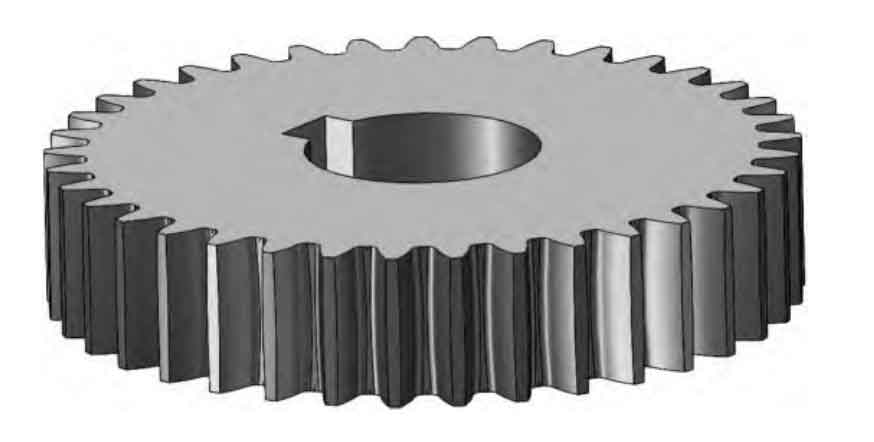This study investigates the tribological behavior and power transmission performance of cylindrical gears with variable hyperbolic circular-arc-tooth-trace (VH-CATT) under mixed lubrication conditions. A comprehensive model integrating contact mechanics, lubrication theory, and surface topography analysis is established to reveal the complex interaction between gear geometry, operating parameters, and lubrication states.
1. Contact Characteristics of VH-CATT Cylindrical Gears
The meshing behavior of cylindrical gears is analyzed through tooth contact analysis (TCA) methodology. The instantaneous contact ellipse parameters are calculated using Hertzian contact theory:
$$a = k_a \left[\frac{3w}{2E(A+B)}\right]^{1/3}$$
$$b = k_b \left[\frac{3w}{2E(A+B)}\right]^{1/3}$$
Where $k_a$ and $k_b$ are elliptical coefficients derived from complete elliptic integrals. The contact characteristics of typical cylindrical gear parameters are shown below:
| Parameter | Gear 1 | Gear 2 |
|---|---|---|
| Number of teeth | 17 | 23 |
| Modulus (mm) | 4 | 4 |
| Pressure angle (°) | 20 | 20 |

2. Mixed Lubrication Model
The unified Reynolds equation for cylindrical gears under mixed lubrication is expressed as:
$$\frac{\partial}{\partial x}\left(\frac{\rho h^3}{12\eta}\frac{\partial p}{\partial x}\right) + \frac{\partial}{\partial y}\left(\frac{\rho h^3}{12\eta}\frac{\partial p}{\partial y}\right) = u_e\frac{\partial(\rho h)}{\partial x} + \frac{\partial(\rho h)}{\partial t}$$
The load-sharing mechanism between asperity contact and fluid film is governed by:
$$F_n = F_h + F_a$$
$$\mu = \frac{f_cF_a + \tau_0A_E}{F_n}$$
3. Friction Characteristics Analysis
The Stribeck curve analysis reveals three distinct lubrication regimes for cylindrical gears:
$$ \mu = \begin{cases}
\mu_{BL} & \text{(Boundary Lubrication)} \\
\mu_{ML} & \text{(Mixed Lubrication)} \\
\mu_{EHL} & \text{(Elastohydrodynamic Lubrication)}
\end{cases} $$
Key findings for cylindrical gear friction behavior include:
- Friction coefficient decreases by 18-22% when speed increases from 500 rpm to 2000 rpm
- Surface roughness (Ra) variation of 0.2-0.8 μm causes 25-40% fluctuation in mixed lubrication friction
- Lubricant viscosity increase from 0.06 Pa·s to 0.12 Pa·s reduces boundary lubrication friction by 30%
4. Transmission Efficiency Modeling
The instantaneous efficiency of cylindrical gear transmission is calculated as:
$$\eta(\phi_i) = 1 – \frac{\sum_{j=1}^{n(i)} f_j(\phi_i)F_{nj}(\phi_i)u_{sj}(\phi_i)}{P_{in}}$$
Experimental validation shows:
| Speed (rpm) | Theoretical Efficiency | Experimental Efficiency |
|---|---|---|
| 1000 | 97.2% | 96.1% |
| 2000 | 98.5% | 97.8% |
5. Parametric Sensitivity Analysis
The influence of key parameters on cylindrical gear performance is quantified through dimensionless analysis:
$$\Lambda = \frac{h_{\min}}{\sqrt{\sigma_1^2 + \sigma_2^2}}$$
$$\overline{\mu} = 0.087(\Lambda)^{-0.67} + 0.012\left(\frac{\eta u_e}{E’R_x}\right)^{0.41}$$
Critical design guidelines for cylindrical gears include:
- Optimum surface roughness ratio: 0.4 ≤ σ/Rq ≤ 0.6
- Recommended viscosity-pressure coefficient: α ≥ 15 GPa⁻¹
- Optimal film thickness parameter: 1.5 ≤ Λ ≤ 3
6. Conclusion
This comprehensive investigation of cylindrical gears under mixed lubrication provides essential insights for designing high-efficiency power transmission systems. The developed models enable accurate prediction of friction behavior and transmission efficiency, particularly for advanced cylindrical gear geometries with variable hyperbolic tooth profiles.
